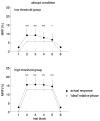Auditory-motor integration of subliminal phase shifts in tapping: better than auditory discrimination would predict
- PMID: 24449013
- PMCID: PMC3958924
- DOI: 10.1007/s00221-014-3837-9
Auditory-motor integration of subliminal phase shifts in tapping: better than auditory discrimination would predict
Abstract
Unilateral tapping studies have shown that adults adjust to both perceptible and subliminal changes in phase or frequency. This study focuses on the phase responses to abrupt/perceptible and gradual/subliminal changes in auditory-motor relations during alternating bilateral tapping. We investigated these responses in participants with and without good perceptual acuity as determined by an auditory threshold test. Non-musician adults (nine per group) alternately tapped their index fingers in synchrony with auditory cues set at a frequency of 1.4 Hz. Both groups modulated their responses (with no after-effects) to perceptible and to subliminal changes as low as a 5° change in phase. The high-threshold participants were more variable than the adults with low threshold in their responses in the gradual condition set. Both groups demonstrated a synchronization asymmetry between dominant and non-dominant hands associated with the abrupt condition and the later blocks of the gradual condition. Our findings extend previous work in unilateral tapping and suggest (1) no relationship between a discrimination threshold and perceptible auditory-motor integration and (2) a noisier sub-cortical circuitry in those with higher thresholds.
Figures






Similar articles
-
Children with developmental coordination disorder (DCD) can adapt to perceptible and subliminal rhythm changes but are more variable.Hum Mov Sci. 2016 Dec;50:19-29. doi: 10.1016/j.humov.2016.09.003. Epub 2016 Sep 19. Hum Mov Sci. 2016. PMID: 27658264
-
Coupling between perception and action timing during sensorimotor synchronization.Neurosci Lett. 2010 Dec 17;486(3):215-9. doi: 10.1016/j.neulet.2010.09.056. Epub 2010 Sep 25. Neurosci Lett. 2010. PMID: 20884327
-
Is there a link between sensorimotor coordination and inter-manual coordination? Differential effects of auditory and/or visual rhythmic stimulations.Exp Brain Res. 2015 Nov;233(11):3261-9. doi: 10.1007/s00221-015-4394-6. Epub 2015 Aug 4. Exp Brain Res. 2015. PMID: 26238405
-
Auditory-motor coupling of bilateral finger tapping in children with and without DCD compared to adults.Hum Mov Sci. 2008 Dec;27(6):914-31. doi: 10.1016/j.humov.2007.11.007. Epub 2008 Jul 17. Hum Mov Sci. 2008. PMID: 18639358 Free PMC article.
-
Brain wave synchronization and entrainment to periodic acoustic stimuli.Neurosci Lett. 2007 Aug 31;424(1):55-60. doi: 10.1016/j.neulet.2007.07.036. Epub 2007 Aug 6. Neurosci Lett. 2007. PMID: 17709189
Cited by
-
Entrainment of Voluntary Movement to Undetected Auditory Regularities.Sci Rep. 2017 Nov 1;7(1):14867. doi: 10.1038/s41598-017-15126-w. Sci Rep. 2017. PMID: 29093545 Free PMC article.
-
Effects of supraspinal feedback on human gait: rhythmic auditory distortion.J Neuroeng Rehabil. 2019 Dec 23;16(1):159. doi: 10.1186/s12984-019-0632-7. J Neuroeng Rehabil. 2019. PMID: 31870399 Free PMC article.
-
Auditory Proprioceptive Integration: Effects of Real-Time Kinematic Auditory Feedback on Knee Proprioception.Front Neurosci. 2018 Mar 8;12:142. doi: 10.3389/fnins.2018.00142. eCollection 2018. Front Neurosci. 2018. PMID: 29568259 Free PMC article.
References
-
- Aschersleben G. Temporal control of movements in sensorimotor synchronization. Brain Cogn. 2002;48:66–79. - PubMed
-
- Drake C, Botte MC. Tempo Sensitivity in Auditory Sequences - Evidence for a Multiple-Look Model. Perception & Psychophysics. 1993;54:277–286. - PubMed
-
- Forrester L, Whitall J. Bimanual finger tapping: effects of frequency and auditory information on timing consistency and coordination. J Mot Behav. 2000;32:176–191. - PubMed
-
- Fraisse P. Anticipation of rhythmic stimuli. Speed of establishment and accuracy of synchronization. Annee Psychol. 1966;66:15–36. - PubMed
-
- Fraisse P. Relationship between the duration of perceptual identification and verbal reaction time. Annee Psychol. 1980;80:433–447. - PubMed
Publication types
MeSH terms
Grants and funding
LinkOut - more resources
Full Text Sources
Other Literature Sources

